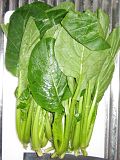Brassica rapa
Brassica rapa[edit]

Brassica rapa is a species of plant in the Brassicaceae family. It is a highly diverse species that includes various subspecies and varieties, many of which are cultivated as food crops. Brassica rapa is native to Europe and Asia and has been widely cultivated for its edible roots, leaves, and seeds.
Description[edit]
Brassica rapa is an annual or biennial plant that can grow up to 1 meter tall. The plant has a rosette of leaves at the base and a flowering stem that bears yellow flowers. The leaves are typically green, but some varieties have purple or red leaves. The root is usually white or yellow and can be round or elongated.
Cultivated Varieties[edit]
Brassica rapa includes several important agricultural crops, each with distinct characteristics:
- Turnip (Brassica rapa subsp. rapa) - Grown for its edible root and leaves.
- Pak Choi (Brassica rapa subsp. chinensis) - A leafy vegetable popular in Asian cuisine.
- Mizuna (Brassica rapa var. nipposinica) - Known for its feathery leaves and mild flavor.
- Komatsuna (Brassica rapa var. perviridis) - Also known as Japanese mustard spinach.
- Bomdong - A type of Korean cabbage.

Uses[edit]
Brassica rapa is cultivated for various purposes:
- Culinary Uses: The leaves, stems, and roots of Brassica rapa are consumed in many cultures. They can be eaten raw, cooked, or pickled.
- Animal Feed: Some varieties are grown as fodder for livestock.
- Oil Production: The seeds of certain varieties are pressed to produce oil.
Cultivation[edit]
Brassica rapa is a cool-season crop that prefers well-drained, fertile soil. It is typically sown in early spring or late summer. The plant requires regular watering and benefits from a balanced fertilizer.

Pests and Diseases[edit]
Brassica rapa is susceptible to several pests and diseases, including:
- Cabbage worms - Larvae that feed on the leaves.
- Clubroot - A disease caused by the pathogen Plasmodiophora brassicae.
- Downy mildew - A fungal disease affecting the leaves.
Related Pages[edit]

Gallery[edit]
-
Historical illustration of Brassica rapa
-
Brassica rapa plant
-
Komatsuna leaves
-
Mizuna leaves
Ad. Transform your life with W8MD's Budget GLP-1 injections from $75


W8MD offers a medical weight loss program to lose weight in Philadelphia. Our physician-supervised medical weight loss provides:
- Weight loss injections in NYC (generic and brand names):
- Zepbound / Mounjaro, Wegovy / Ozempic, Saxenda
- Most insurances accepted or discounted self-pay rates. We will obtain insurance prior authorizations if needed.
- Generic GLP1 weight loss injections from $75 for the starting dose.
- Also offer prescription weight loss medications including Phentermine, Qsymia, Diethylpropion, Contrave etc.
NYC weight loss doctor appointmentsNYC weight loss doctor appointments
Start your NYC weight loss journey today at our NYC medical weight loss and Philadelphia medical weight loss clinics.
- Call 718-946-5500 to lose weight in NYC or for medical weight loss in Philadelphia 215-676-2334.
- Tags:NYC medical weight loss, Philadelphia lose weight Zepbound NYC, Budget GLP1 weight loss injections, Wegovy Philadelphia, Wegovy NYC, Philadelphia medical weight loss, Brookly weight loss and Wegovy NYC
|
WikiMD's Wellness Encyclopedia |
| Let Food Be Thy Medicine Medicine Thy Food - Hippocrates |
Medical Disclaimer: WikiMD is not a substitute for professional medical advice. The information on WikiMD is provided as an information resource only, may be incorrect, outdated or misleading, and is not to be used or relied on for any diagnostic or treatment purposes. Please consult your health care provider before making any healthcare decisions or for guidance about a specific medical condition. WikiMD expressly disclaims responsibility, and shall have no liability, for any damages, loss, injury, or liability whatsoever suffered as a result of your reliance on the information contained in this site. By visiting this site you agree to the foregoing terms and conditions, which may from time to time be changed or supplemented by WikiMD. If you do not agree to the foregoing terms and conditions, you should not enter or use this site. See full disclaimer.
Credits:Most images are courtesy of Wikimedia commons, and templates, categories Wikipedia, licensed under CC BY SA or similar.
Translate this page: - East Asian
中文,
日本,
한국어,
South Asian
हिन्दी,
தமிழ்,
తెలుగు,
Urdu,
ಕನ್ನಡ,
Southeast Asian
Indonesian,
Vietnamese,
Thai,
မြန်မာဘာသာ,
বাংলা
European
español,
Deutsch,
français,
Greek,
português do Brasil,
polski,
română,
русский,
Nederlands,
norsk,
svenska,
suomi,
Italian
Middle Eastern & African
عربى,
Turkish,
Persian,
Hebrew,
Afrikaans,
isiZulu,
Kiswahili,
Other
Bulgarian,
Hungarian,
Czech,
Swedish,
മലയാളം,
मराठी,
ਪੰਜਾਬੀ,
ગુજરાતી,
Portuguese,
Ukrainian



